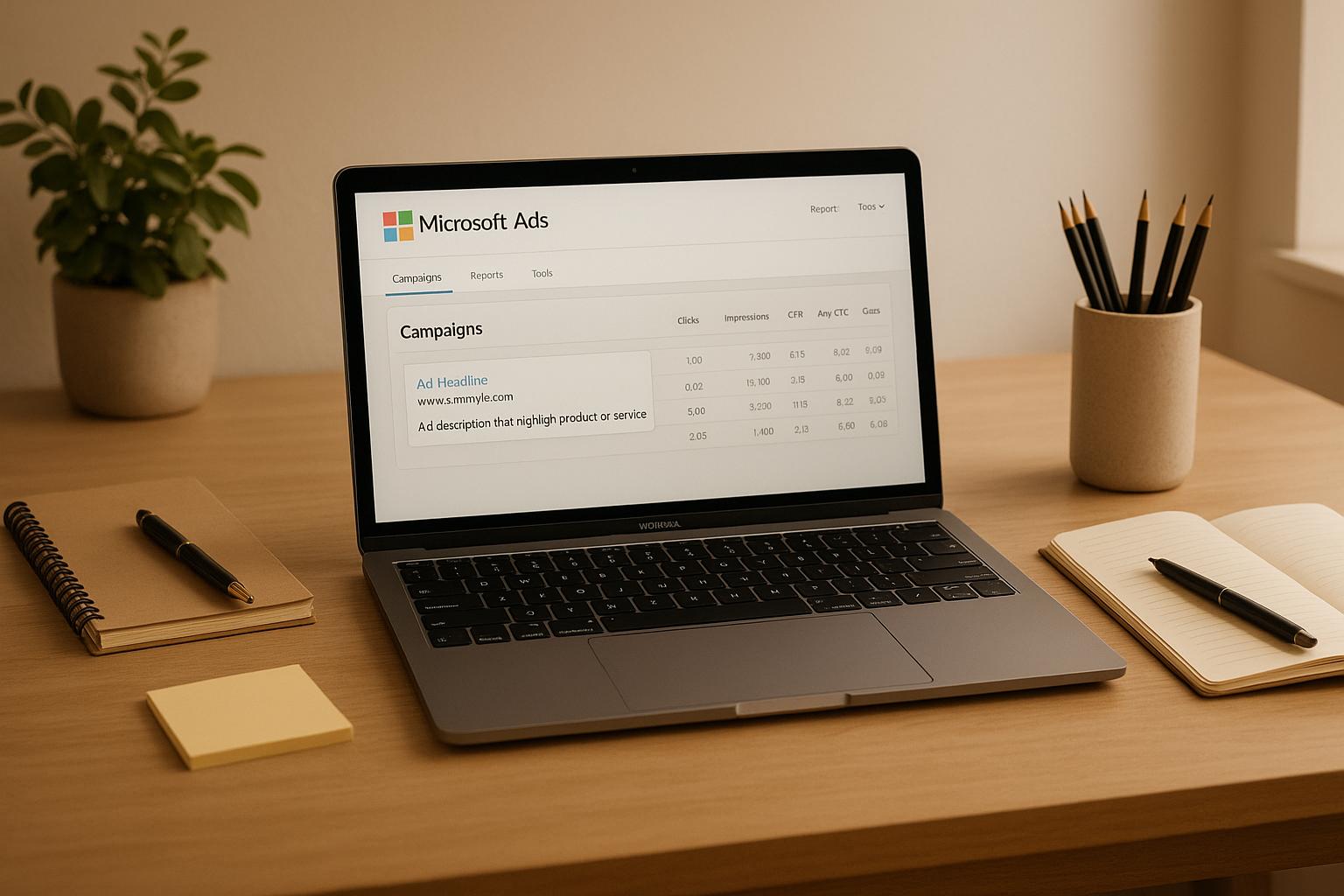Want to improve your PPC campaigns? Start by benchmarking your competitors. This means analyzing their ad performance, strategies, and budgets to find opportunities to optimize your own campaigns. Here's what you need to know:
- Why it matters: Gain insights into industry trends, optimize performance, and allocate your budget more effectively.
- Key steps: Identify competitors, analyze their ad strategies, research keywords, and track metrics like CTR, CPC, and conversion rates.
- Tools to use: Platforms like SpyFu, Ahrefs, and Google Ads' Auction Insights can help track competitor activity and uncover actionable data.
- Best practices: Focus on audience insights, monitor budget allocation, and identify trends to refine your strategy.
Use these strategies to stay ahead of the competition and maximize your PPC ROI.
Mastering Competitive Intelligence in PPC
Elements of PPC Competitor Benchmarking
Identifying Competitors
Pinpointing the right competitors is a crucial first step in effective benchmarking. Tools like Google Ads' Auction Insights provide real-time data on advertisers competing for the same ad space, offering key metrics like impression share and overlap rate.
Platforms such as SpyFu and Ahrefs go further, offering insights into competitors' keyword strategies, ad spend, and audience overlap. Here are some key areas to consider:
| Analysis Type | What You'll Learn | Key Metrics |
|---|---|---|
| Direct Competition | Who’s bidding on the same keywords | Impression share, position above rate |
| Indirect Competition | Businesses targeting similar audiences | Audience overlap, market segments |
| Market Position | Visibility within your industry | Ad spend, keyword coverage |
After identifying competitors, dive into their ad strategies to uncover actionable insights.
Analyzing Competitor Ad Strategies
Studying competitors' ads can provide valuable direction for your campaigns. Tools like the Top PPC Marketing Directory can help track changes in competitor ads over time.
When analyzing competitor ads, pay close attention to:
- Ad Copy and Value Propositions: Look at headlines, descriptions, and unique selling points.
- Landing Page Relevance: Check how well their ads align with their destination pages.
- Extra Features: Note any extensions or enhancements that make their ads stand out.
Beyond ad messaging, understanding how competitors approach keywords is essential for staying competitive.
Keyword Research and Metrics
Keyword research becomes more powerful when paired with competitor insights. Tools like SE Ranking and Google Ads Transparency Center can help identify gaps in competitor keyword strategies and reveal untapped opportunities [1][2].
For a thorough keyword analysis, focus on these areas:
- Performance metrics like CTR and Quality Score
- Competition indicators such as impression share and CPC
- Growth opportunities, including search volume and conversion rates
Key practices to keep in mind:
- Monitor top-performing keywords used by competitors.
- Track shifts in bidding strategies.
- Identify seasonal trends in keyword usage.
- Analyze how ad copy aligns with chosen keywords.
These insights can help fine-tune your campaigns and give you an edge in targeting the right keywords.
Best Practices for Benchmarking
Using Data for Audience Insights
To make PPC benchmarking effective, you need to systematically analyze competitor data. This helps refine your targeting and messaging, ultimately boosting engagement. Tools like SpyFu and Ahrefs can provide detailed metrics about audience behavior and engagement trends.
When conducting audience analysis, focus on these critical areas:
| Analysis Area | Metrics to Track | Strategic Value |
|---|---|---|
| Demographics | Age, location, device usage | Ensures alignment with your target audience |
| Engagement and Search Behavior | Click-through rates, conversion paths, search terms | Helps fine-tune content and keyword strategies |
Once you’ve mapped out your audience, dive into how competitors allocate their budgets. This can reveal which demographics and strategies they prioritize.
Analyzing Competitor Budget Allocation
Looking at how competitors spend their PPC budgets can uncover their high-priority keywords and peak spending times. These insights are crucial for shaping your own strategy.
Pay attention to:
- Seasonal spending patterns: Observe how budgets shift during key periods and which campaigns get priority.
- Ad position strategy: Track changes in ad rankings for important keywords to understand their bidding behavior.
Budget analysis is just one piece of the puzzle. Keeping an eye on broader industry trends can also help you stay ahead.
Identifying Trends for Best Practices
Analyzing trends across competitors can help you set industry benchmarks and spot new opportunities. Resources like the Top PPC Marketing Directory offer tools to track changes in ad strategies and landing page performance.
Some key trends to monitor include:
- Audience preference shifts: Watch for changes in messaging and value propositions that resonate with your audience.
- Technical improvements: Pay attention to effective use of ad extensions and strategies for boosting conversions.
Rather than copying competitors, look for patterns that work and adapt them to create campaigns that are distinct yet effective. This approach ensures your efforts remain both relevant and impactful.
sbb-itb-89b8f36
Applying Insights to PPC Strategies
Optimizing Keyword Strategy
Create a keyword plan that draws from competitor performance. Focus on keywords that strike a balance between manageable competition and high search volume to boost ROI.
| Strategy Component | Action Items | Expected Impact |
|---|---|---|
| Gap Analysis | Find keywords your competitors use but you don't | Reach untapped audience segments |
| Performance Tracking | Keep an eye on changes in competitor keywords | Adjust to market trends and shifts |
| Cost Efficiency | Focus on lower-cost keywords with high conversions | Increase campaign profitability |
Once your keyword strategy is in place, it's time to craft ad copy that connects with your audience.
Enhancing Ad Copy and Messaging
Take inspiration from what works in competitor campaigns, but keep your brand's voice and position clear.
"Claire Aldridge emphasizes the importance of in-depth competitor analysis for better market-aligned recommendations."
To refine your ad copy, analyze elements that make competitor ads successful:
- Headline Structure: Look for patterns in competitor headlines that grab attention.
- Value Propositions: Highlight unique benefits that fill gaps in competitor messaging.
- Call-to-Action: Experiment with CTAs that align with what resonates in your market.
Effective Budget Allocation
Competitor data can also guide smarter budget decisions, helping you focus on areas that drive the best results. Align your spending with high-performing keywords and impactful ad copy to get the most out of your campaigns.
Key budget allocation tips:
- Focus spending on high-converting keywords, especially during peak seasons when competition heats up.
- Invest in areas where competitors are falling short, giving you an edge in the market.
The Top PPC Marketing Directory is a great resource for tools that track and refine budget allocation across campaigns. Use these insights to stay ahead and boost your ROI.
Resources for PPC Competitor Benchmarking
Top PPC Marketing Directory
The Top PPC Marketing Directory is a go-to resource for PPC professionals looking for tools and services tailored to competitor analysis. It includes options for campaign analysis, competitor research, and planning strategies to improve performance.
Tools for Benchmarking
Analyzing PPC competitors requires tools that provide insights into their strategies. Different platforms offer unique features to help you dig into the details:
- SEMrush: Great for keyword gap analysis and tracking historical ad performance.
- SpyFu: Ideal for uncovering competitor budget trends and shifts in ad strategies.
- Google Ads Auction Insights: Provides real-time metrics like impression share and overlap rates to gauge competition.
When choosing and using benchmarking tools, keep these tips in mind:
- Pick tools that turn data into clear, actionable steps.
- Use multiple tools to cross-check data for better accuracy.
- Prioritize metrics that directly tie to your campaign goals.
- Blend insights into your current PPC strategy for maximum impact.
The success of your competitor benchmarking depends on finding the right mix of tools that align with your goals. By using these resources wisely, you can turn competitor data into strategies that improve your PPC campaigns.
Conclusion and Key Points
Summary of Best Practices
Running effective PPC competitor benchmarking means sticking to a detailed, data-focused process. Keeping an eye on your competitors and staying updated on market trends is key. The goal is to dive into their ad strategies, keyword choices, and budget patterns while staying aligned with your own business goals.
Pay attention to metrics like CTR, quality scores, and ad positions. Compare these against industry standards to set achievable targets and pinpoint areas that need work. While learning from competitors, focus on crafting campaigns that highlight your own unique strengths.
Now, let’s look at how to turn these insights into actionable steps for your campaigns.
Next Steps for Campaigns
Take what you’ve learned from competitor benchmarking and apply it with these practical steps:
- Set Clear Objectives: Define specific KPIs that align with your goals.
- Establish Regular Reviews: Schedule consistent check-ins to track competitor activity.
- Use the Right Tools: Take advantage of analysis platforms to gather and interpret data.
The Top PPC Marketing Directory (ppcmarketinghub.com) is a helpful resource for boosting your benchmarking efforts. Regularly benchmarking and applying these insights can lead to stronger campaign results.
Use competitor data to refine your keyword strategy, improve ad copy, and allocate your budget more effectively. This ensures your PPC campaigns stay sharp, adaptable, and deliver measurable outcomes as the market evolves.


